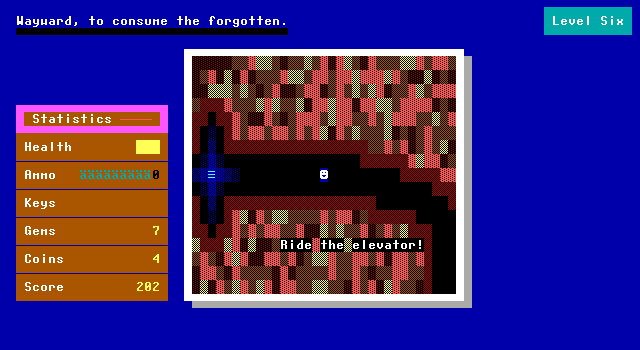
Wayward is having some issues. Again the caption has changed for the new level. The outer limits of the level are filled with fire.
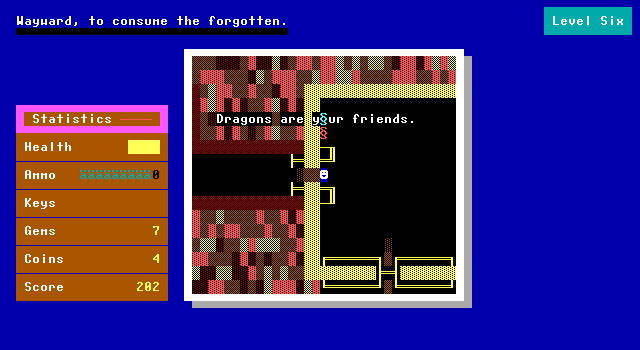
There's a forced fight against two more dragons here, who are most certainly not Forrester's friends.
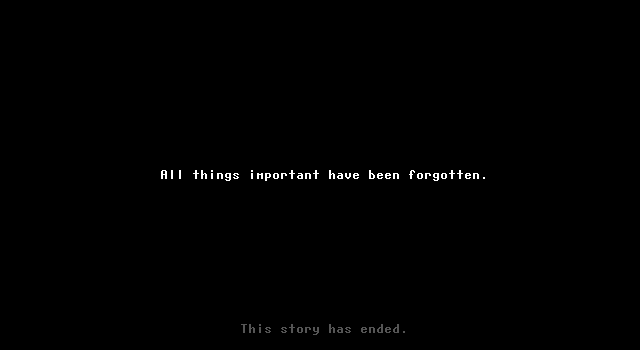
In fact, they managed to kill me. This is the game over screen the player is taken to.
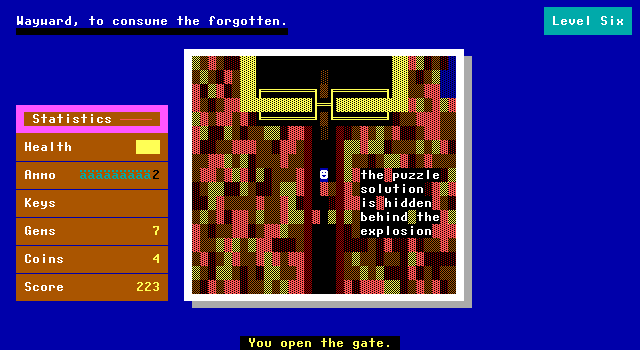
A second attempt fares much better. The outside world is hinting at how to solve puzzles now, and some of the fire has begun to spread inside. Forrester is about to get abstract.
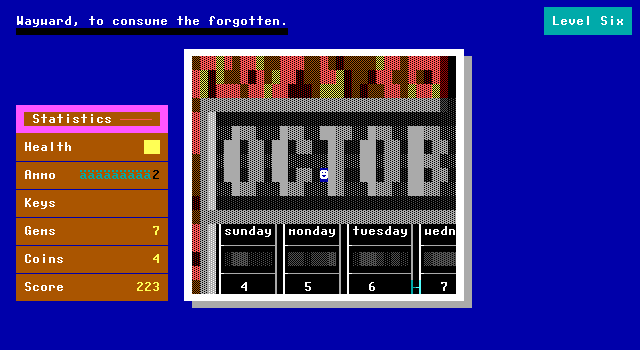
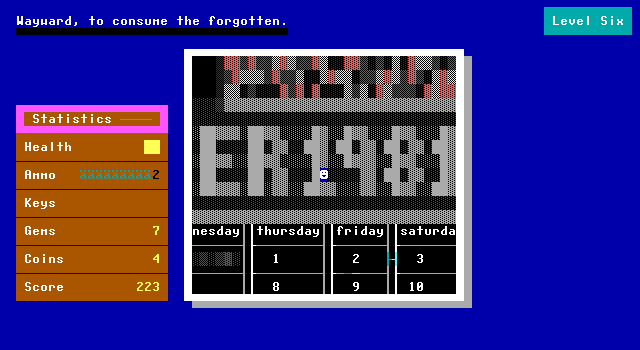
Forrester finds himself on a giant old calendar. Most of it is solid, but the cyan colored tiles can be walked over, making a bit of a maze.
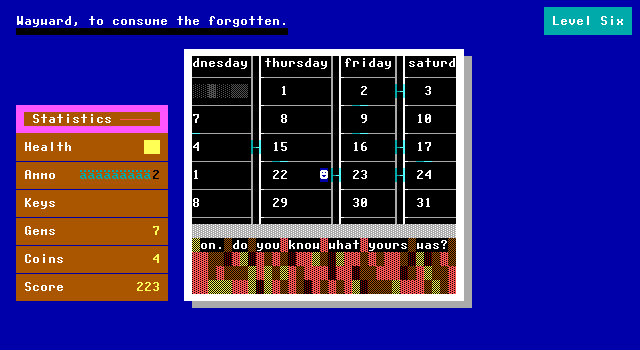
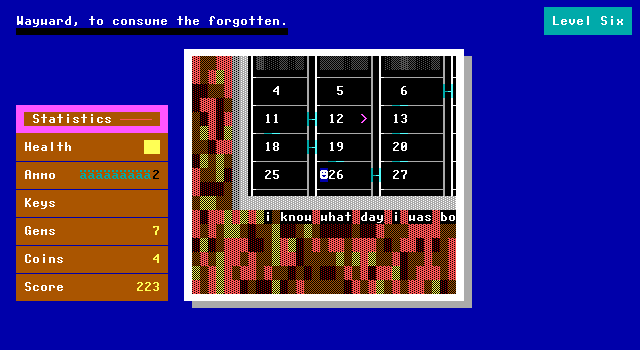
Along the bottom of the calendar is the text "i know what day i was born on. do you know what yours was?"
I guess it's the 12th since that's the only day with a transporter out of the calendar and onto the next area.
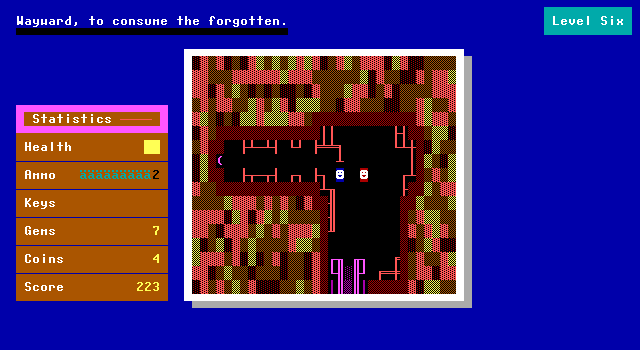

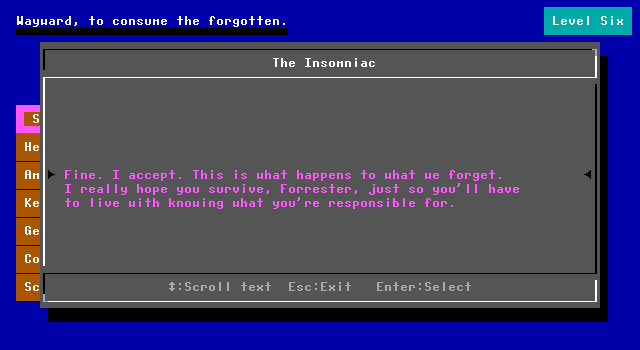
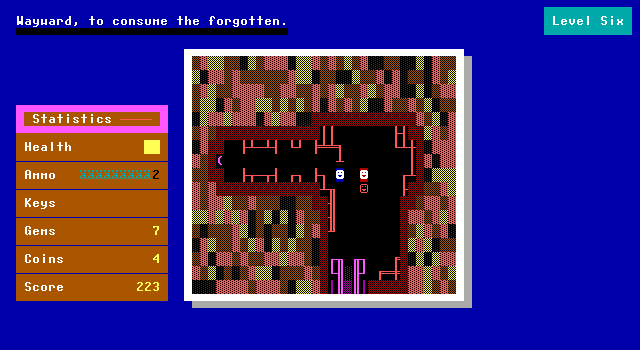
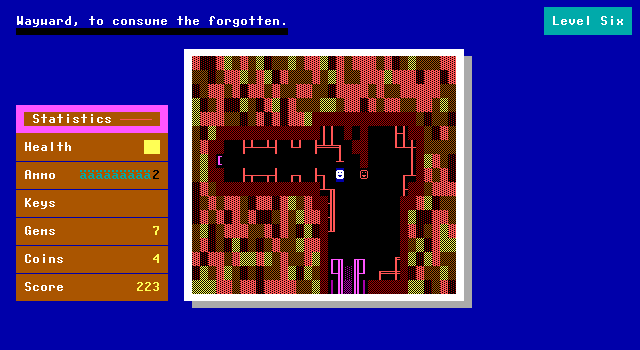
Wayward is really falling apart now. The insomniac gives up and is violently killed by the demon, leaving streaks of blood along the ground.
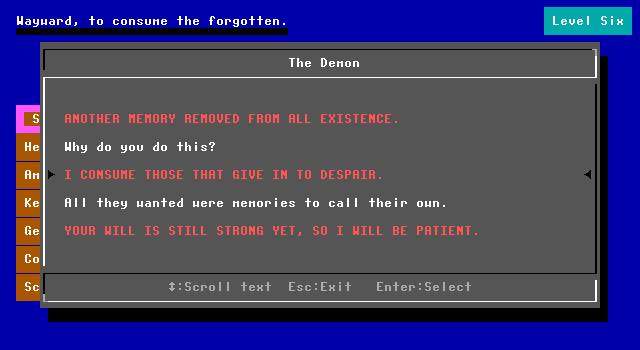
The demon intends to erase Forrester as well, but can't consume those who haven't given up.
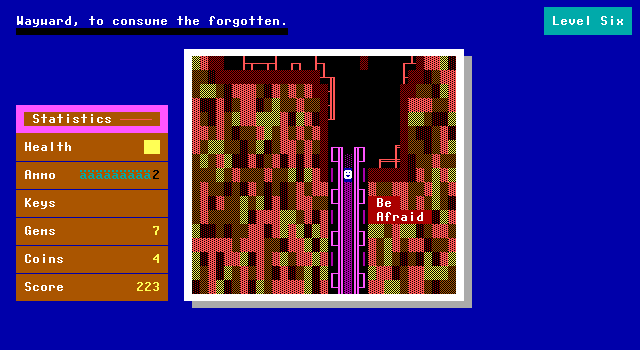
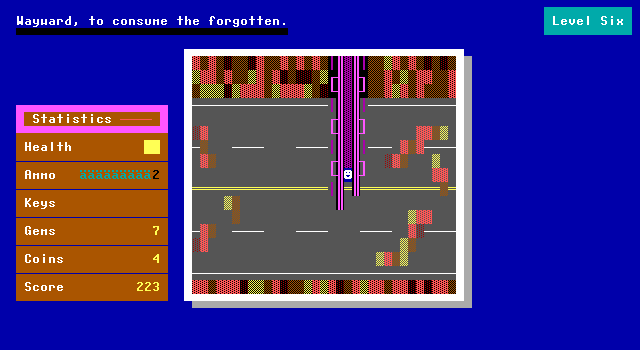
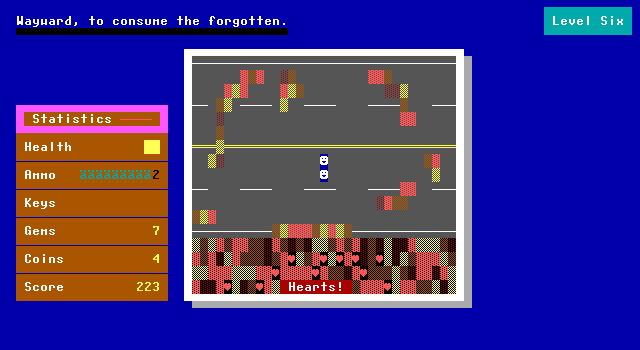
The bridge leads onto what looks like a highway. The road is littered with more fire, and most peculiarly an object that looks identical to Forrester.
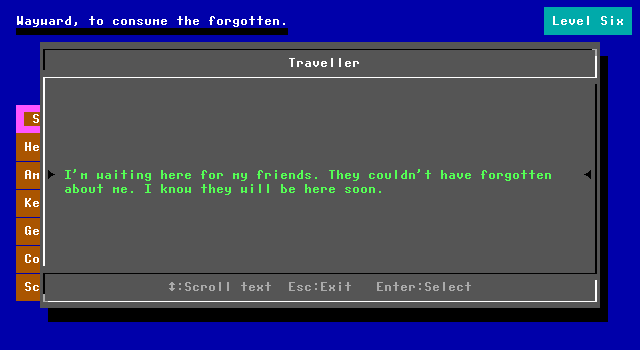
The appearance of an object with the same colors as Forrester seems very deliberate. Was this how he was forgotten and brought to Wayward? Was there some sort of car accident to explain all the fire around him? It's unclear what this all actually means, but I don't think an interpretation of Forrester being dead and Wayward being him spending his last moments trying to think about his daughter is too outlandish.
There are some hearts alongside the road in the fire, but venturing in would be certain death.
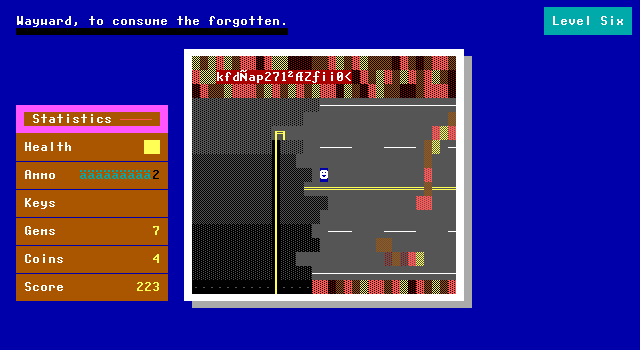
Just past the traveller the road ends, a strange sign is in the fire, and a rope descends downwards into a pit.
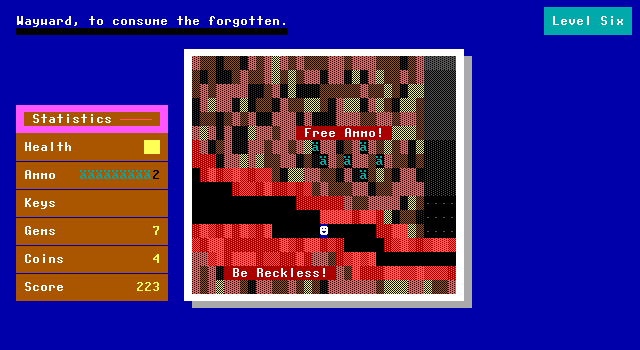
The pit has walls lined with lava. While fire rapidly damages a player foolish enough to stand in it, lava instantly kills the player if they don't have any extra lives.
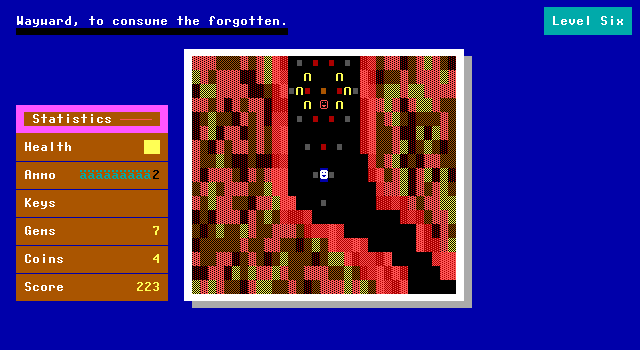
At the end of the lava cave is the demon on his throne.
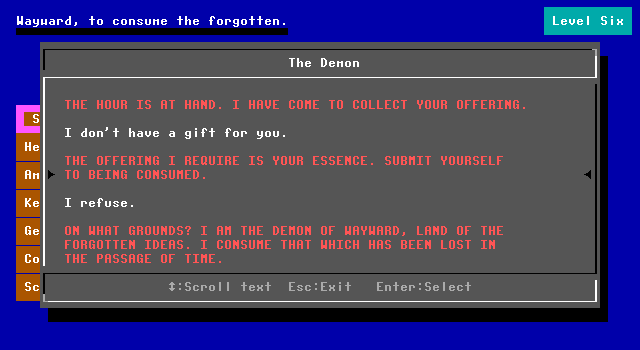

The demon vows to break Forrester's spirit to keep the natural order of Wayward going. He leaves and the passage to the seventh and final level is revealed.
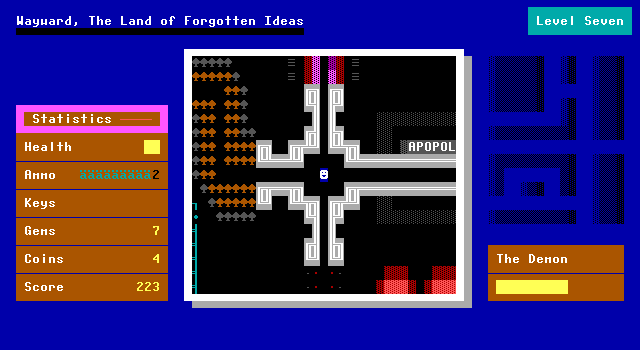
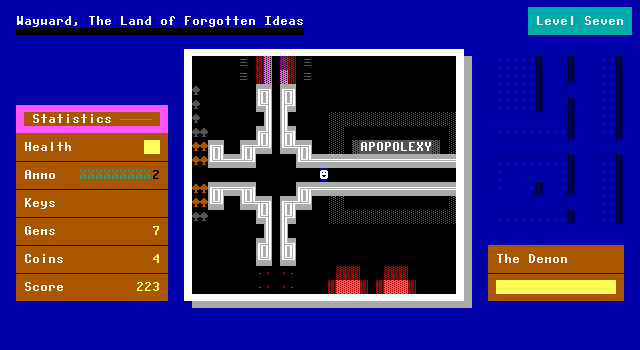
Wayward, The Land of Forgotten Ideas. It's the final level and the player is given their choice of paths to take with the goal of finding and destroying the demon. The HUD also has some odd markings on the normally blank right side of the screen.
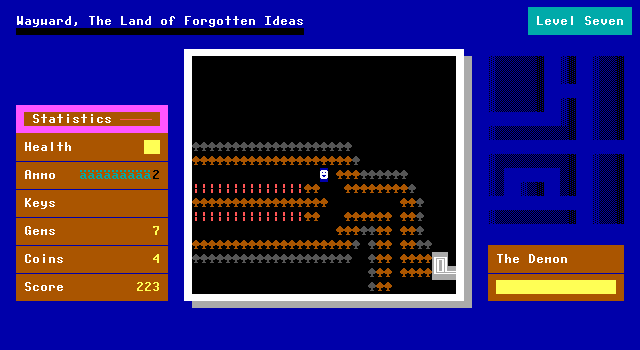
To the west are dead trees and a series of conveyors.
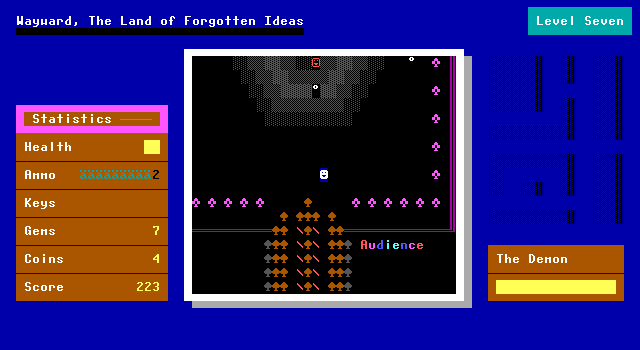
The conveyors carry the player into a small arena with the demon. An audience of ruffians watches the fight. The demon doesn't do anything too complex, just moving and shooting. When he's hit however, he disappears briefly before reappearing elsewhere nearby in order to prevent spamming bullets into him all at once.
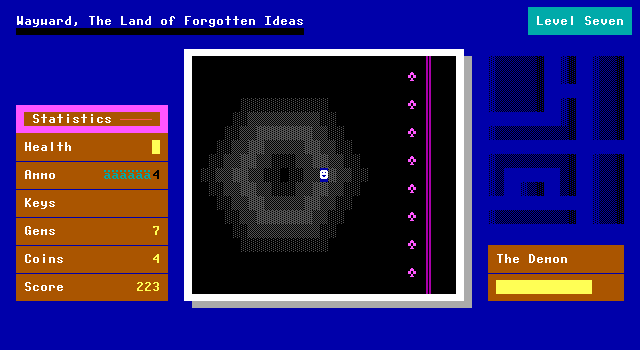
After dealing enough damage to the demon, he disappears from the arena entirely, and the player has to search for him on a new path.
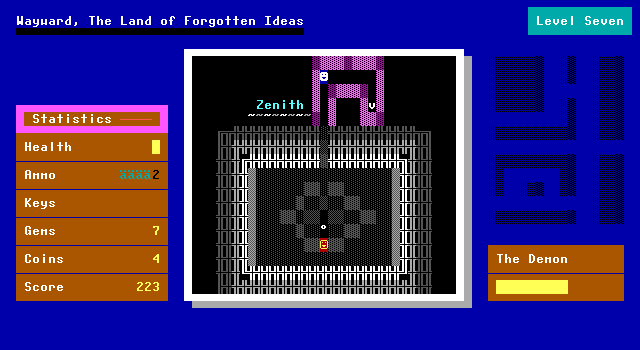
To the north is a purple passageway which leads to a second, much smaller arena by way of transporter. In this phase of the fight it's easy to just stand safely outside of it and shoot inward until the next phase ends.
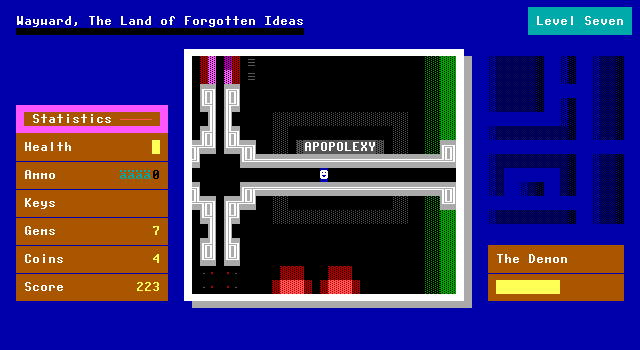
To the east, is the word "apopolexy". Oh dear.
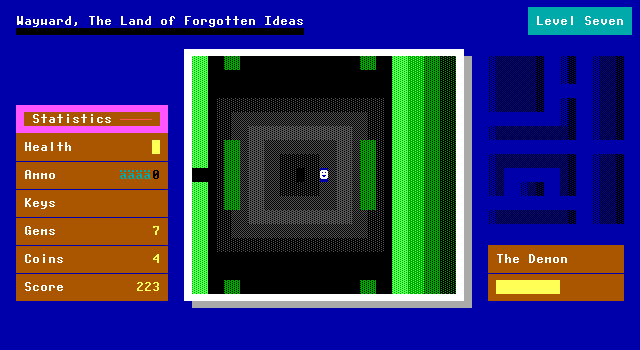
There's a more vertically oriented arena, but no demon to be found.
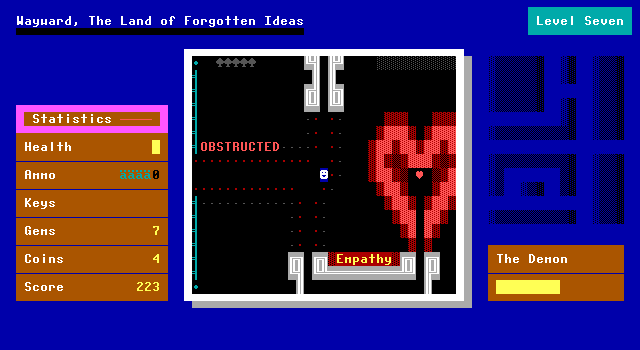
To the south, the path splits further. Near the empathy text is a large heart which contains a regenerating heart powerup within. It takes awhile to respawn so if you're low on health and want to restore it a noticeable amount, you'll be in for quite a wait.
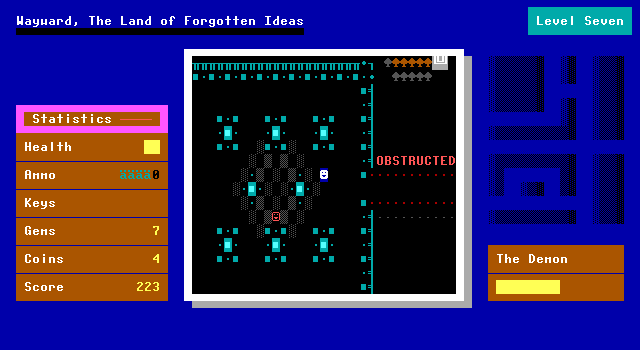
The next arena has the demon and a series of walls blocking sightlines. This makes it difficult to get in a good shot against the demon.
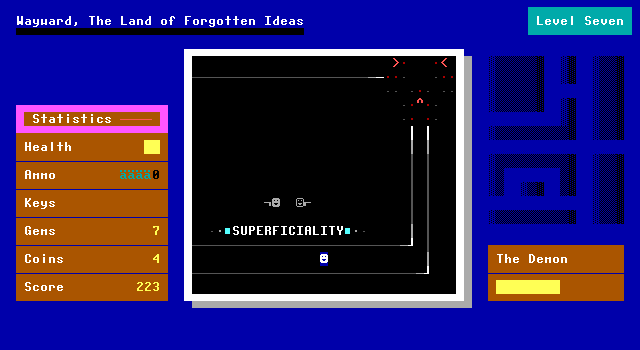
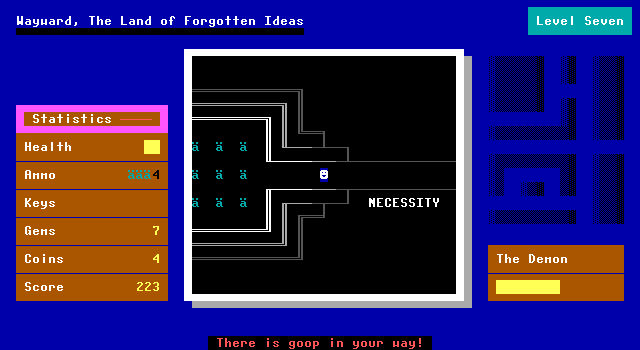
The other path contains more concepts outside the walls. Superficiality and necessity. Superficiality is just that, a path that leads right back to the same path necessity takes, making it pointless.
Necessity thankfully contains several ammo items which respawn almost immediately after being collected, at the very least the fight with the demon can't become impossible to win with these infinite sources of health and ammo.
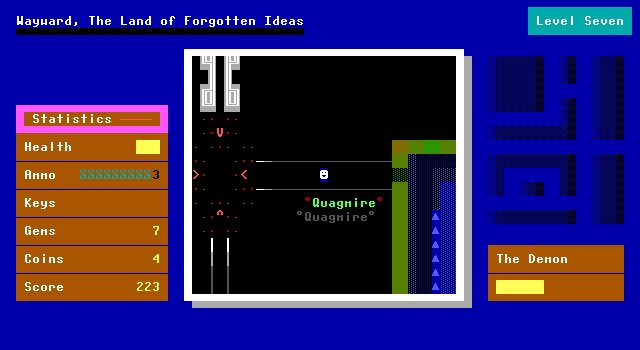
The last path of the second branch is quagmire.
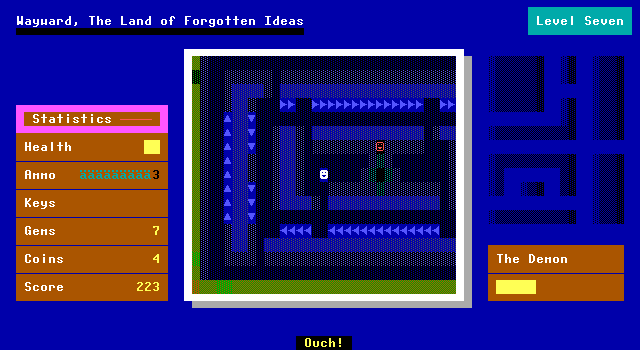
Here the demon can be fought in another constrained area, but this time the walls are made out of goop. Goop is a MegaZeux element that's identical to ZZT's water, a wall that bullets can travel over but not the player or enemies.
It takes a few trips for ammo to actually get him to move once more as the demon really doesn't stick around in one place for long at all.
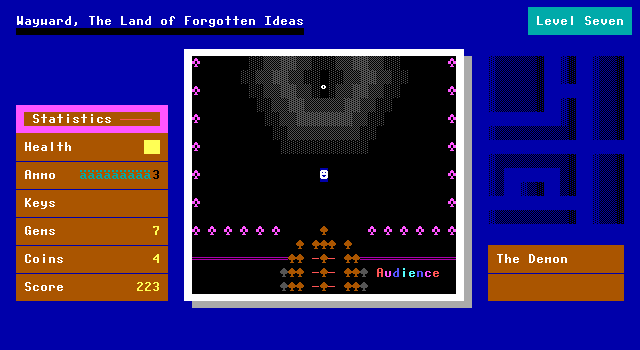
He eventually retreats back to the first arena, on the verge of death before being hit with that one final bullet.
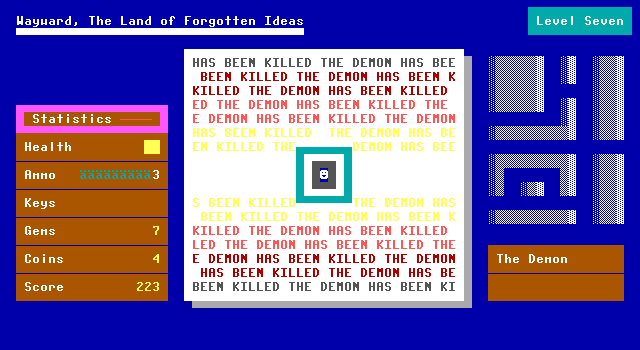
The screen flashes bright white and some creepypasta text covers the screen.
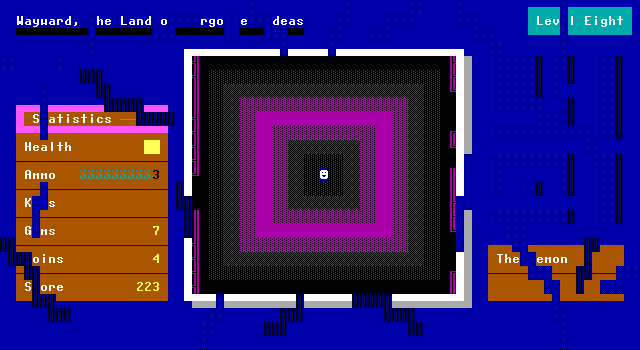
The fourth wall is shattered as Wayward can no longer function. Not only is the world broken, but the game's own HUD is damaged irreparably as the player enters level eight.
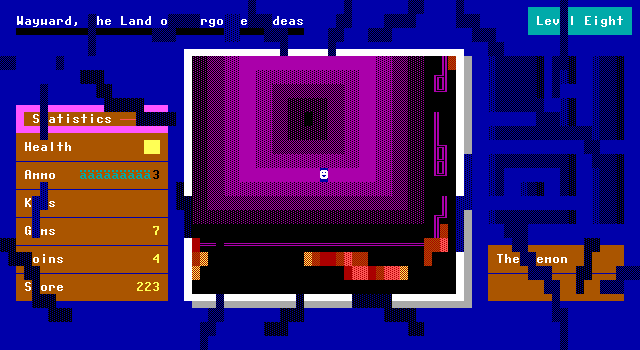
The eighth level is a purple room with damaged walls and fire. There's nothing left.
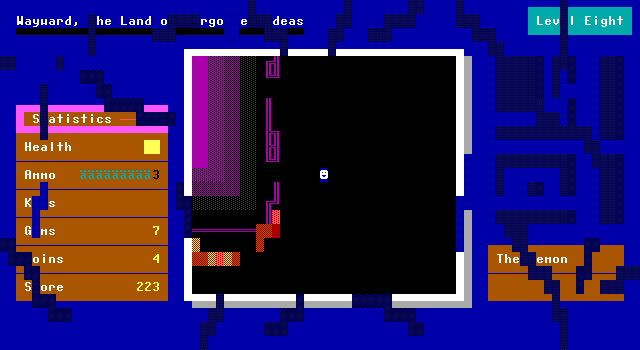
Forrester is free.

Free to wander in the darkness.
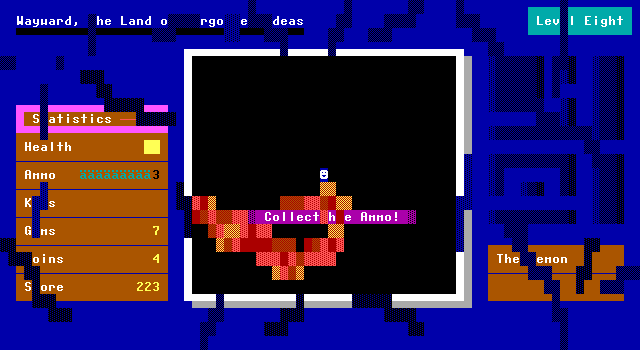
But it's not all gone. Some remnants of Wayward do remain.

"forgotten ideas are abound
the world in which wayward is contained
it is the source from which those ideas
flow from the mind and into nothingness"
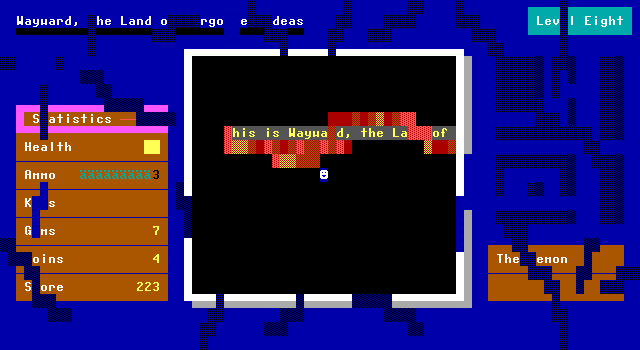

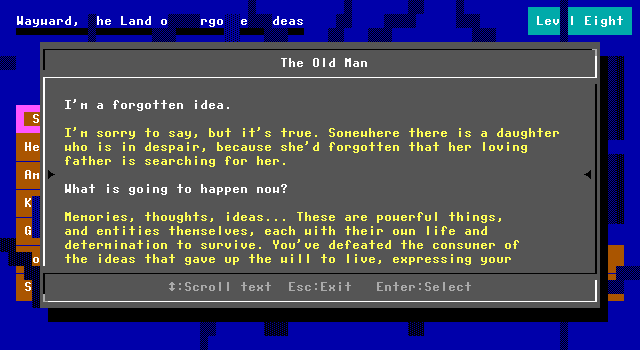
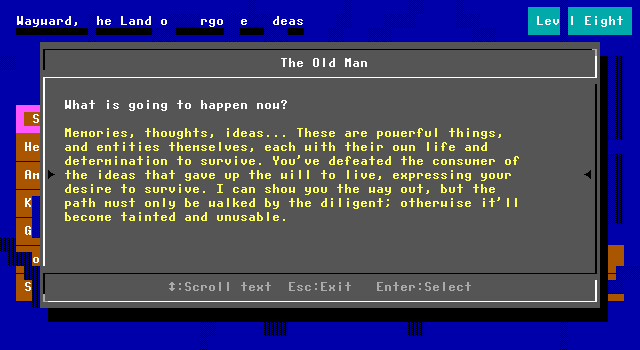
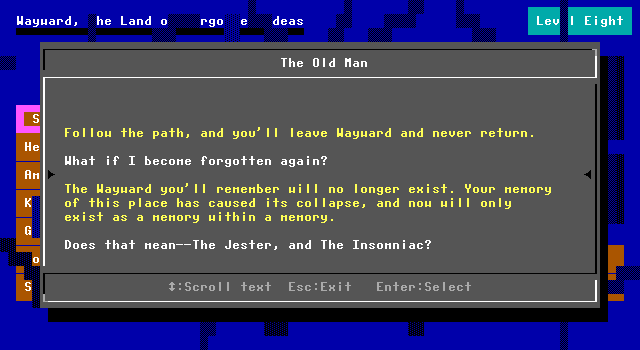
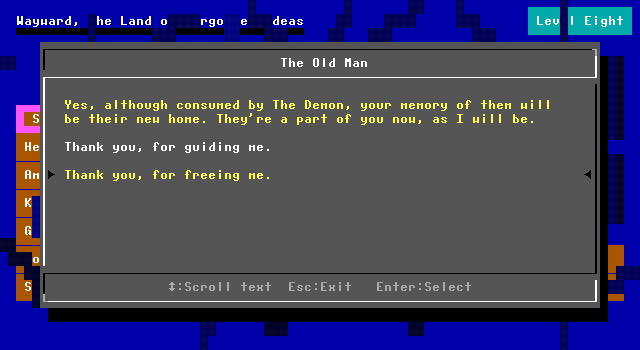
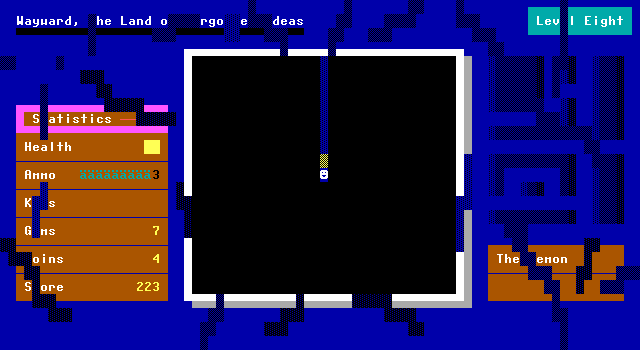
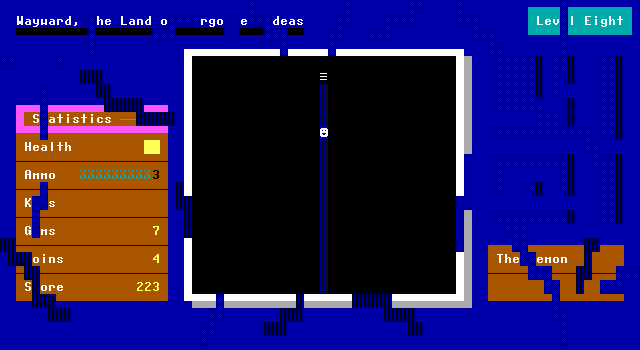
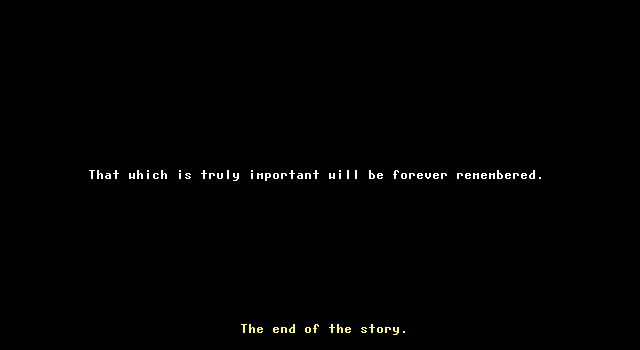
The old man is still here, and offers Forrester the way out of what was once known as Wayward. Though the Wayward as we knew it has been destroyed, it still lives on in its own way, along with the jester and the insomniac in Forrester's own memories.
Final Thoughts
Forrester is a rather unexpected combination of Super ZZT aesthetics with more serious themes expressed by its characters. Memory, the loss of it, and being lost are all some heavier topics that you wouldn't expect to see in such a colorful Monster Zoo inspired environment. I think it works out for the best that way, rather than a silly find some keys and get to the exit Super ZZT style game while a dark brooding game about being forgotten would easily fall prey to style over substance, a game to put on the shelves at Hot Topic.
By mixing the two together, Forrester becomes something unique. It's neither light-hearted nor overwrought existential angst. It's a fun journey through a more whimsical Wayward with the game's cast keeping the player from getting caught up in a fantasy world by questioning itself. Forrester had the good fortune of being released within a year of MegaZeux's port to Windows, which meant a lot of ZZTers who previously never bothered with the engine were now taking a look at what they had been missing out on. Forrester was well received within the MegaZeux community, but its aesthetics were probably more of a hit with ZZTers branching out.
The gameplay is very light, and can feel a bit like filler at times (especially when it's literally just that when playing games with the jester). Forrester was made in a time where a game without any traditional video game mechanics could face scorn as "not a game", and I have to wonder if Inmate didn't want to deal with any such accusations. If you take the ruffians and tigers out of Forrester, they wouldn't be missed, but what action is there is still basic and brief enough that while it doesn't add to the game, it doesn't detract from it either.
When you play Forrester, you're playing it for the storyline, and that's where Inmate's work with Forrester gains its substance. The characters moods swing a bit too rapidly, though they do the job of making the player think whether or not the actions they're taking in Wayward are the right ones just because they're the ones that go forward. Forrester only really scratches the surface of this compared to something like Undertale's ideas of what it means to make certain choices in games. Forrester's only choices are whether to keep going forward or to quit playing.
The game's story also suffers from being ultimately vague. There's a lot of discussion about memories being destroyed, but there's not much explanation on it. Sometimes it's very literal, with Forrester remembering he was blocked by a wall, which causes it to vanish from Wayward, but throughout the rest of the game Forrester, the jester, the old man, and the insomniac all converse and remember each other without issue. The insomniac's level is destroyed, but the UFO is revisited. I suppose it's a distinction of remembering things and experiencing them. The later levels when Wayward begins to crack also bring up unanswered questions about the significance of the calendar or the highway and Forrester looking traveller. It's hard to tell what's in Forrester to create a cohesive journey and what's there to make sure there's something there at all. I can read the traveller as Forrester being forgotten by his friends, and the game certainly doesn't have to explicitly explain itself, but despite the tone shift in the latter half of the game, there's no real indication that there was a _why_ for the tone shift.
It could all be a load of bunk. It could be a thoughtful piece about being forgotten. It could be Super ZZT. It could be MegaZeux. I'm not sure what Forrester is, but it's something that stands out as a bridge between two related budding game developer communities. If you're looking for a good stepping stone into MegaZeux and have experience with ZZT, don't forget about Forrester.


